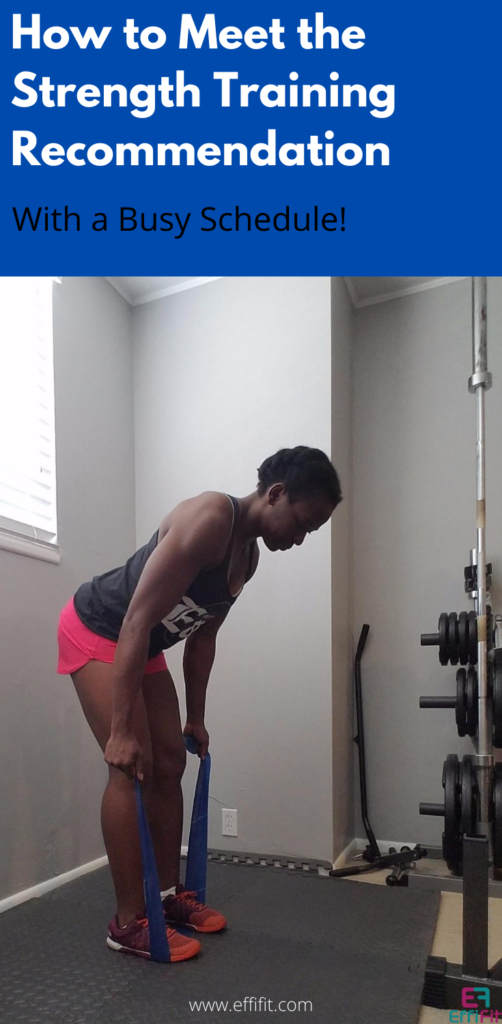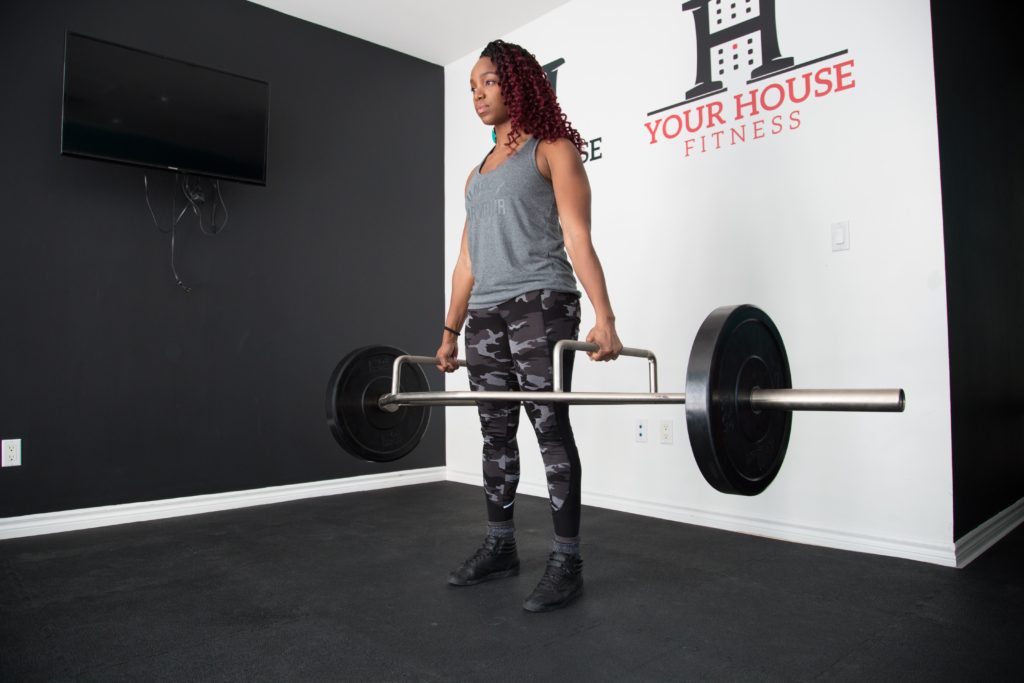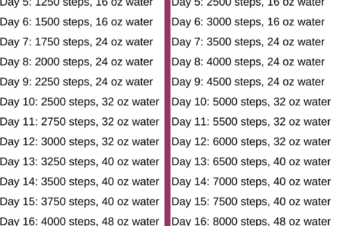The strength training recommendation set out for us is pretty straightforward. But getting there can be a challenge with so many different ways to strength train. Let’s break down the most common ways to strength train and help you find one that works for you and your schedule.
*This post contains affiliate links. I earn a small commission from purchases through links to any products or services from this website. Your purchase helps support my work in bringing you real information about living the FitLife with a busy schedule.

Types of strength training
There are many types of strength training. All can help you meet the strength training recommendation. Let’s start by breaking down the 4 most common.
Endurance
With endurance strength training, the goal is to have your muscles work for you for an extended period of time. Activities to increase muscle endurance often include a high number of reps with your body weight or light weights.
What counts as a high number of reps? Generally more than 12 reps (number of times you do an exercise) per set (number of times you perform reps of an exercise). So that could be doing 20 squats at a time or 15 pushups at a time. It could also be doing 30 walking lunges with light weight. Endurance strength training works as a great option if you’re working out at home and don’t have weights to make the exercises more challenging. Increasing the number of reps (by increasing reps or sets) you do will make it harder and also build your muscle endurance.
Strength
Strength training is the most common form. This is where the strength training recommendation comes from, so you probably hear about it a lot. The goal is to build muscle strength. Generally there are weights involved, and the weights increase as you get stronger. With strength training programming, you’ll see increases in weight and number of sets. Your rep count ranges from 3-10 rep per exercise per set, with more rest involved in between sets to allow your muscles to recover. Increasing strength is achieved through the progression in the heaviness of the weights. Heavier weights often result in fewer sets at least initially. As you get stronger, you will be able to do more reps at that heavier weight.
In terms of weights, strength training can be achieved using dumbbells, kettlebells, barbells, and heavy stuff around the house. It’s beneficial here to have a varying level of weights so you can keep increasing and growing your strength.

Photo by Sergio Pedemonte on Unsplash
Hypertrophy
Hypertrophy is the third form of strength training. The focus here is to build muscle mass and begin the process of having muscle definition. Muscle definition doesn’t come strictly from lifting weights, there is a major nutrition component and emphasis on fat loss.
Some might refer to hypertrophy as bulking up. This is also the same as being “toned.” Building muscle mass usually involves moving through a full range of motion at 8-12 reps per exercise per set. Variety is useful here to keep your muscles from getting used to the weight, exercises, or volume. For example, one day you may do dumbbell front squats, and the next strength training session you do goblet squats. You are still squatting, but you are do variations of the move to keep your muscles engaged. As you get stronger, increasing weight will also help to keep your muscles guessing and growing.
Hypertrophy training can be achieved by using dumbbells, barbells, kettlebells, and more with a variety of exercise movements.
Power
Power training is lifting and moving heavy heavy shiz very few times. If you’ve ever seen a Strong Man competition or watched a powerlifting competition, this is power training. Reps are basically 1-3 per set. The goal is to produce as much power in a short amount of time. You’ll be lifting really heavy stuff but only for a little bit of time. Power training can be achieved by progressively lifting heavier things. The important piece here is the small amount of reps. That is lifting something really heavy just a couple of times. There is often quite a bit of rest between sets to allow your muscles to recover.

Photo by Alora Griffiths on Unsplash
What kind of equipment can I use for strength training
Now that we are familiar with some of the most common ways to strength train, let’s talk about the different ways you can go about incorporating them into your strength training routine.
Body weight exercises – body weight exercises are great in general and especially useful when you have limited to no exercise equipment. With body weight exercises, you can take full advantage of endurance strength training.
TRX – TRX and similar pieces of equipment are great to have at home because they take up very little space and are very versatile. You can use these to do a total body strength workout. TRX and similar products are great for endurance strength training, strength training, and hypertrophy training.
Dumbbells – The use of dumbbells ticks the box for all 4 of the strength training options. You can use light weights to do more reps for endurance strength training. You can progressively increase weight for strength training and hypertrophy training, and you can use super heavy dumbbells for power training. If you’re working out at home, it’s really beneficial to have multiple weights of dumbbells or consider a pair of adjustable dumbbells. I have a pair in my home gym and love the ability to increase or decrease weight without having a whole bunch of dumbbells laying around the house.
Kettlebells – Kettlebells can serve the same purpose as dumbbells in that they can be used for all 4 of the strength training options. There are even kettlebell specific programs you can follow to achieve the strength training recommendations. I find them to be fun and challenging. They can add a lot of variety to your training. You can find a set of kettlebells if you’re working out at home or look for adjustable ones. I’m in the process of this and will report back what I find.

Photo by Sergio Pedemonte on Unsplash
Barbells – Barbells are the bees knees! And if you have a gym that allows them not attached to a machine, even better. If you’re working at home and have space for a barbell and some plates, then yes. If not, no worries, you can make great use of dumbbells, kettlebells, and resistance bands. Barbells are great for some endurance strength training but are better used doing strength training, hypertrophy training, and power training.
Resistance bands – resistance bands are amazing because they take up very little space and are easy to store. Additionally, you can get sets of varying resistance so as you get stronger, you can continue to challenge your muscles. You have a few options for resistance bands. There are small looped bands (great for booty work); big looped bands, and straight bands. All can play a role in your strength training program. Resistance bands work best for endurance strength training and strength training. They can be helpful in hypertrophy training too.
Different ways to meet the strength training recommendation
The 2 most common ways to meet the strength training recommendation of training all your major muscles groups at least 2 times a week are to train them all in one exercise session or to use a split routine.
Train all major muscle groups each time – This means you do strength training exercises for your upper body, your lower body, and core all in one training session. With this option, you would do strength training at least 2 times a week to meet the strength training recommendation.
Split routines – Split routines are when you break up your strength training sessions usually by body part. For example, you might have a day when you just do upper body exercises or lower body exercises. This can be broken down even further by body parts. Maybe on Mondays you do chest and back, Tuesdays you do (legs) quads and hamstrings, Wednesdays you do shoulders and abs. Split routines can be a great option when you’re short on time per session, but it does mean that to hit all those muscle groups at least twice in a week, you would be strength training up to 6 times a week.
The time you have available to strength train and your specific goals with strength training will determine if you train all your major muscle groups each time or if you decide on some sort of split routine.
Ways to meet the strength training recommendation
Traditional strength training on the same day as aerobic exercise
The first option is traditional strength training on the same day as you do your aerobic exercise. You can do strength training first (where I lean and how I order my fitness) and then aerobic exercise or aerobic exercise first (which can be a great way to ensure your body is super warm before you start lifting) and then do your strength training. Traditional strength training looks like: 3-4 sets of 8-12 reps per exercise. You can do 3-4 sets of each exercise at a time; 3-4 sets of 10 dumbbell squats with a 1-3 minute rest in between sets. Or you can do all the exercises together as one set. For example doing 10 dumbbell squats, 10 dumbbell chest presses, 10 dumbbell deadlifts, and 10 dumbbell bent over rows back to back as one set. Repeat that 3-4 times, resting 1-3 minutes after each set.
Traditional strength training on different days as cardio
The second option is to complete your traditional strength training on a different day than your aerobic exercise. You may do strength training Monday, Wednesday, Friday and aerobic exercise Tuesday, Thursday, and Saturday.

Photo by Tyler Nix on Unsplash
Circuit training as strength training
Circuit training is another great way to meet the strength training recommendation. For this one, you complete the exercises in a circuit meaning you move from one exercise to the next with minimal rest in between movements. You would still complete a certain amount of sets. The circuit can be total body or it can be certain body parts. You could also do multiple circuits in one workout. There’s a lot of options and ways to get creative with circuit training. Depending on your goals, you can do circuits for endurance strength training, strength training, or hypertrophy training.
HIIT training as strength training
HIIT training can also work as strength training. You can do intervals where you’re doing a movement for a certain amount of time and then resting. You can do endurance strength training at a quick pace. I personally think HIIT training as strength training works best for endurance strength training. As you start lifting heavier weight, slowing down to ensure form is high quality is very important.
Traditional strength training and circuit or HIIT training
Here you can combine a few strength training options. This is one that I do. I’ll start my workout with some traditional strength training (usually one big lift such as back squat, bench press, or deadlift). Then I’ll move into a circuit for 20-30 minutes or a HIIT workout. This allows me to focus on one big lift but still work all my major muscle groups through the circuits and HIIT workouts. It also provides quite a bit of variety and challenge for my muscles. Imagine doing a heavy session of back squats and then turning around and doing bodyweight squats in a HIIT workout. Good stuff!
Picking a method of strength training that works for you
I like to incorporate the different types of strength training but you can stick to just one or two. From what we’ve learned, there a a few options to choose from and ways to set it up. Try out one or 2 that are of interest to you or meet your strength training goals. You can always switch it and try something new if it doesn’t work out. Variety in exercise is a good thing. If you are uncertain of where to start, I would recommend endurance strength training or strength training. As you get the hang of things, you can explore the other options. If you’re still confused and need some help, please reach out and let’s figure it out together.
Until next time! – Atim
*EffiFit LLC is a participant in the Amazon Services LLC Associates Program, an affiliate advertising program designed to provide a means for sites to earn advertising fees by advertising and linking to amazon.com.






Leave a Reply